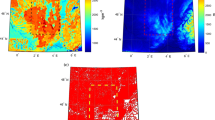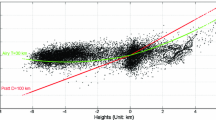Abstract.
One important application of an Earth Gravity Model (EGM) is to determine the geoid. Since an EGM is represented by an external-type series of spherical harmonics, a biased geoid model is obtained when the EGM is applied inside the masses in continental regions. In order to convert the downward-continued height anomaly to the corresponding geoid undulation, a correction has to be applied for the analytical continuation bias of the geoid height. This technique is here called the geoid bias method. A correction for the geoid bias can also be utilised when an EGM is combined with terrestrial gravity data, using the combined approach to topographic corrections. The geoid bias can be computed either by a strict integral formula, or by means of one or more terms in a binomial expansion. The accuracy of the lowest binomial terms is studied numerically. It is concluded that the first term (of power H2) can be used with high accuracy up to degree 360 everywhere on Earth. If very high mountains are disregarded, then the use of the H2 term can be extended up to maximum degrees as high as 1800. It is also shown that the geoid bias method is practically equal to the technique applied by Rapp, which utilises the quasigeoid-to-geoid separation. Another objective is to carefully consider how the combined approach to topographic corrections should be interpreted. This includes investigations of how the above-mentioned H2 term should be computed, as well as how it can be improved by a correction for the residual geoid bias. It is concluded that the computation of the combined topographic effect is efficient in the case that the residual geoid bias can be neglected, since the computation of the latter is very time consuming. It is nevertheless important to be able to compute the residual bias for individual stations. For reasonable maximum degrees, this can be used to check the quality of the H2 approximation in different situations.
Similar content being viewed by others
Author information
Authors and Affiliations
Corresponding author
Additional information
Acknowledgement The author would like to thank Prof. L.E. Sjöberg for several ideas and for reading two draft versions of the paper. His support and constructive remarks have improved its quality considerably. The valuable suggestions from three unknown reviewers are also appreciated.
Rights and permissions
About this article
Cite this article
Ågren, J. The analytical continuation bias in geoid determination using potential coefficients and terrestrial gravity data. Journal of Geodesy 78, 314–332 (2004). https://doi.org/10.1007/s00190-004-0395-0
Received:
Accepted:
Published:
Issue Date:
DOI: https://doi.org/10.1007/s00190-004-0395-0




